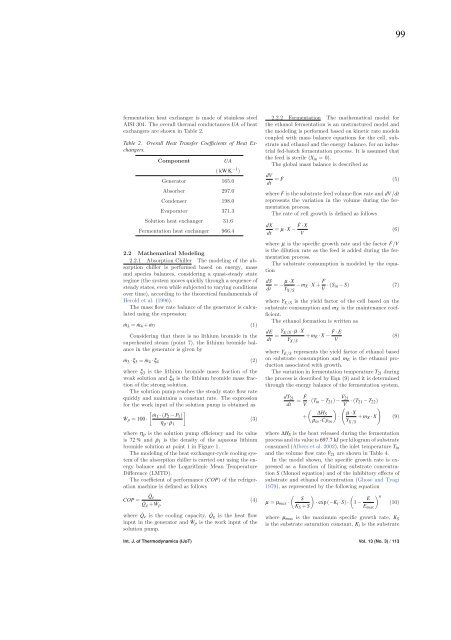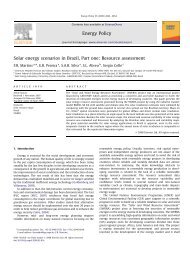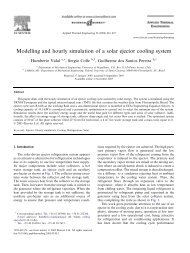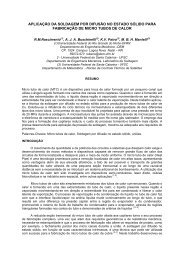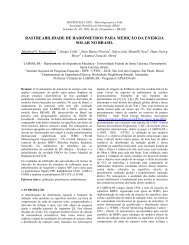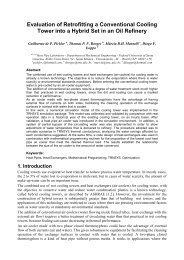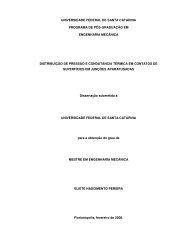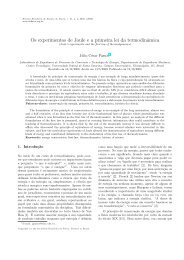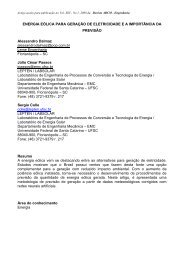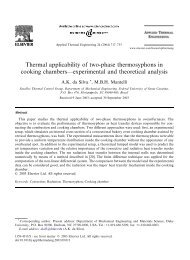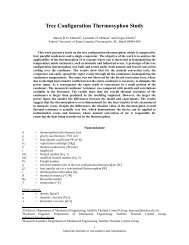98Figure 1. Schematic diagram of the cooling system forethanol fermentation using a single-effect absorption <strong>chiller</strong>.capi@ of Figure 1, are: generator, absorber, con<strong>de</strong>nser,evaporator, solution heat exchanger, solution p<strong>um</strong>p, expansionvalve and throttling valve. Firstly, the weak solutionof lithi<strong>um</strong> bromi<strong>de</strong> is p<strong>um</strong>ped from the low pressureregion in the absorber to the high pressure region inthe generator where heat is supplied by the waste heatsource (point 11) and the refrigerant water is separatedfrom aqueous lithi<strong>um</strong> bromi<strong>de</strong> solution by evaporation.The superheated steam (point 7) goes through the con<strong>de</strong>nserwhere it is con<strong>de</strong>nsed on the surface of a coolingcoil. The saturated water, that leaves the con<strong>de</strong>nser, isthrottled through the expansion valve to the lower pressurein the evaporator, where it evaporates by absorbingheat and provi<strong>de</strong>s cooling capacity (point 18). The saturatedsteam from the evaporator (point 10) flows tothe absorber where it is absorbed by the strong solutionoriginating from the generator. The mixing processintheabsorberisexothermicandneedstorejectheattransferring it to the water from the con<strong>de</strong>nser. Theweak solution, which leaves the absorber, is p<strong>um</strong>ped tothe generator and goes through the solution heat exchangerwhere it is heated, and the refrigeration processbegins again.One constraint of the single-effect water/lithi<strong>um</strong> bromi<strong>de</strong>absorption <strong>chiller</strong> is the crystallization of the absorbent(lithi<strong>um</strong> bromi<strong>de</strong>) and the point of the cyclemost vulnerable in this regard is the stream entering theabsorber (point 6), because of its highly concentratedsolution and low temperature.The absorption <strong>chiller</strong> has a nominal cooling capacityof 3000 kW and it chills two fermentation vats. Thecooling capacity of the absorption <strong>chiller</strong> was selectedconsi<strong>de</strong>ring the availability of waste heat at the plant.This study only shows the refrigeration of one fermentationvat, thus the mass flow rate of the chilled waterfrom the evaporator is divi<strong>de</strong>d into two streams. Thevol<strong>um</strong>e flow rate and the temperature of some streamsin the absorption <strong>chiller</strong> are shown in Table 1. The configurationof the water loop inlet in the absorption <strong>chiller</strong>is: con<strong>de</strong>nser (point 15) and evaporator (point 17) usethe water from the cooling tower, the absorber uses thewater that leaves the con<strong>de</strong>nser (point 16) to reject heat.Usually commercial absorption <strong>chiller</strong>s use inverse configuration(from absorber to con<strong>de</strong>nser) in or<strong>de</strong>r to avoidcrystallization. As the operation temperature rangedoes not present risk of crystallization, it is reliable tooperate un<strong>de</strong>r the configuration <strong>de</strong>scribed above, allowinghigher COP (Herold et al. 1996). The generator isheated by the contaminated con<strong>de</strong>nsate from the juiceevaporation process during sugar production (point 11).The water used to cool the fermentation vat is a mixtureos chilled water (point 18) and water from coolingtower (point 23). The simulation of the cooling tower isbeyond the scope of this analysis.Table 1. Vol<strong>um</strong>e Flow Rate and Temperature of SomeStreams in the Absorption Chiller.Point ˙V T( m 3 h −1 ) ( ◦ C)1 26 –11 350 9613 800 T 1615 800 T 2317 450 T 23The ethanol fermentation (region slowromancapii@ inFigure 1) is a biochemical process where the sugars aretransformed into alcohol by the industrial yeast Saccharomycescerevisiae. The carbon source used is canemolasses. The fermentation time ranges from 4 to 6hplus the wait time (1 to 3h) and there are two fermentationprocesses per day for each vat. At the end of thefermentation, all sugars have been cons<strong>um</strong>ed and thefinal fermentation product, called wine, has an ethanolconcentration of 60 to 90 kg m −3 .The heat released during the ethanol fermentation isremoved by means of a plate heat exchanger, where thecold stream (point 19) is provi<strong>de</strong>d by both streams, waterfrom the cooling tower (point 23) and from the evaporatorof the absorption <strong>chiller</strong> (point 18). The mustfrom the fermentation vat (point 21) flows to the fermentationheat exchanger with a constant vol<strong>um</strong>e flowrate and the flow rate of the cold stream (point 19) isused as a manipulated variable to control the fermentationtemperature.The heat exchangers of the process are in a counterflow arrangement. Plate heat exchangers are used at thesolution heat exchanger of the absorption <strong>chiller</strong> and fermentationheat exchanger, while those of the absorption<strong>chiller</strong> are shell and tube heat exchangers. The absorption<strong>chiller</strong> heat exchangers are ma<strong>de</strong> of copper while the112 / Vol. 13 (No. 3) Int. Centre for Applied Thermodynamics (ICAT)
99fermentation heat exchanger is ma<strong>de</strong> of stainless steelAISI 304. The overall thermal conductances UA of heatexchangers are shown in Table 2.Table 2. Overall Heat Transfer Coefficients of Heat Exchangers.ComponentUA( kW K −1 )Generator 165.0Absorber 297.0Con<strong>de</strong>nser 198.0Evaporator 371.3Solution heat exchanger 31.6Fermentation heat exchanger 966.42.2 Mathematical Mo<strong>de</strong>ling2.2.1 Absorption Chiller The mo<strong>de</strong>ling of the absorption<strong>chiller</strong> is performed based on energy, massand species balances, consi<strong>de</strong>ring a quasi-steady stateregime (the system moves quickly through a sequence ofsteady states, even while subjected to varying conditionsover time), according to the theoretical fundamentals ofHerold et al. (1996).Themassflowratebalanceofthegeneratoriscalculatedusing the expressionṁ 3 = ṁ 4 + ṁ 7 (1)Consi<strong>de</strong>ring that there is no lithi<strong>um</strong> bromi<strong>de</strong> in thesuperheated steam (point 7), the lithi<strong>um</strong> bromi<strong>de</strong> balancein the generator is given byṁ 3 ·ξ 3 = ṁ 4 ·ξ 4 (2)where ξ 3 is the lithi<strong>um</strong> bromi<strong>de</strong> mass fraction of theweak solution and ξ 4 is the lithi<strong>um</strong> bromi<strong>de</strong> mass fractionof the strong solution.The solution p<strong>um</strong>p reaches the steady state flow ratequickly and maintains a constant rate. The expressionfor the work input of the solution p<strong>um</strong>p is obtained as][ṁ1 · (PẆ p = 100· 2 − P 1)(3)η p ·ρ 1where η p is the solution p<strong>um</strong>p efficiency and its valueis 72 % and ρ 1 is the <strong>de</strong>nsity of the aqueous lithi<strong>um</strong>bromi<strong>de</strong> solution at point 1 in Figure 1.The mo<strong>de</strong>ling of the heat exchanger-cycle cooling systemof the absorption <strong>chiller</strong> is carried out using the energybalance and the Logarithmic Mean TemperatureDifference (LMTD).The coefficient of performance (COP) oftherefrigerationmachine is <strong>de</strong>fined as follows˙Q eCOP =(4)˙Q g +Ẇ pwhere ˙Q e is the cooling capacity, ˙Q g is the heat flowinput in the generator and Ẇ p is the work input of thesolution p<strong>um</strong>p.2.2.2 Fermentation The mathematical mo<strong>de</strong>l forthe ethanol fermentation is an unstructured mo<strong>de</strong>l andthe mo<strong>de</strong>ling is performed based on kinetic rate mo<strong>de</strong>lscoupled with mass balance equations for the cell, substrateand ethanol and the energy balance, for an industrialfed-batch fermentation process. It is ass<strong>um</strong>ed thatthe feed is sterile (X in =0).The global mass balance is <strong>de</strong>scribed asdV= Ḟ (5)dtwhere Ḟ is the substrate feed vol<strong>um</strong>e flow rate and dV/dtrepresents the variation in the vol<strong>um</strong>e during the fermentationprocess.Therateofcellgrowthis<strong>de</strong>finedasfollowsdX= μ ·X − Ḟ ·X(6)dtVwhere μ is the specific growth rate and the factor Ḟ/Vis the dilution rate as the feed is ad<strong>de</strong>d during the fermentationprocess.The substrate cons<strong>um</strong>ption is mo<strong>de</strong>led by the equationdSdt = − μ ·X − m X ·X + Ḟ · (Sin − S) (7)Y X/S Vwhere Y X/S is the yield factor of the cell based on thesubstrate cons<strong>um</strong>ption and m X is the maintenance coefficient.The ethanol formation is written asdE= Y E/S · μ ·X+ m E ·X − Ḟ ·Edt Y X/S V(8)where Y E/S represents the yield factor of ethanol basedon substrate cons<strong>um</strong>ption and m E is the ethanol productionassociatedwithgrowth.The variation in fermentation temperature T 21 duringthe process is <strong>de</strong>scribed by Eqn (9) and it is <strong>de</strong>terminedthrough the energy balance of the fermentation system.dT 21= Ḟdt V · (Tin − T21) − ˙V 21 · (T21 − T22)V( ) ()ΔHS μ ·X+· + m X ·Xρ in ·Cp in Y X/S(9)where ΔH S is the heat released during the fermentationprocess and its value is 697.7kJper kilogram of substratecons<strong>um</strong>ed (Albers et al. 2002), the inlet temperature T inand the vol<strong>um</strong>e flow rate ˙V 21 areshowninTable4.In the mo<strong>de</strong>l shown, the specific growth rate is expressedas a function of limiting substrate concentrationS (Monod equation) and of the inhibitory effects ofsubstrate and ethanol concentration (Ghose and Tyagi1979), as represented by the following equation( )(Sμ = μ max · · exp(−K i ·S)· 1 − E ) n(10)K S + SE maxwhere μ max is the maxim<strong>um</strong> specific growth rate, K Sis the substrate saturation constant, K i is the substrateInt. J. of Thermodynamics (IJoT) Vol. 13 (No. 3) / 113
- Page 1:
UNIVERSIDADE FEDERAL DE SANTA CATAR
- Page 4 and 5:
Catalogação na fonte pela Bibliot
- Page 7:
A toda minha família e amigos. . .
- Page 11:
Quem, de três milênios,Não é ca
- Page 15:
ABSTRACTEthanol fermentation is an
- Page 18 and 19:
Figura 20 Sistema de resfriamento d
- Page 20 and 21:
Figura 59 Diagrama de Dühring do r
- Page 23 and 24:
LISTA DE SÍMBOLOSSímbolos GeraisA
- Page 25:
SsttrvXwwbwkSubstratoForteTorre de
- Page 28 and 29:
4.3.7 Bomba de Solução . . . . .
- Page 30 and 31:
2A relação entre a energia renov
- Page 32 and 33:
4energia disponíveis no setor sucr
- Page 34 and 35:
6Cana de AçúcarRecepçãoCana de
- Page 36 and 37:
8A levedura é um microorganismo te
- Page 38 and 39:
10(a) Variação diária da tempera
- Page 40 and 41:
12efeitos, obtendo-se então os vap
- Page 42 and 43:
142.2 REFRIGERAÇÃO POR ABSORÇÃO
- Page 44 and 45:
16sorção intermitente, onde exist
- Page 46 and 47:
18Tabela 1 - Volume específico dos
- Page 48 and 49:
20segue,COP ca =COP =˙Q e˙Q g(2.4
- Page 50 and 51:
22Figura 14 - Diagrama de Dühring
- Page 52 and 53:
242.2.4 RESFRIADORES DE ABSORÇÃO
- Page 54 and 55:
26Figura 17 - Resfriador de absorç
- Page 56 and 57:
28em etanol foram encontrados para
- Page 58 and 59:
303.4 RESFRIADOR DE ABSORÇÃOSiste
- Page 60 and 61:
32ses como Japão, China e Coréia
- Page 63 and 64:
354 MODELAGEM MATEMÁTICA4.1 FERMEN
- Page 65 and 66:
37Tabela 5 - Dados fermentativos co
- Page 67 and 68:
39onde t é o tempo final do proces
- Page 69 and 70:
41onde a relação ω é expressa p
- Page 71 and 72:
43Tabela 8 - Dados de entrada da si
- Page 73 and 74:
45como segue,Cp g M gdT gdt= ∑ i(
- Page 75 and 76: 47O balanço de massa é expresso p
- Page 77 and 78: 49ção,(T 14 = T 13 + (T a − T 1
- Page 79: 51pode ocorrer o fenômeno da crist
- Page 82 and 83: 54Definição dos parâmetrosde ent
- Page 84 and 85: 56Figura 29 - Sistema de refrigera
- Page 86 and 87: 58Figura 31 - Efeito de uma queda a
- Page 88 and 89: 60Figura 34 - Efeito da variação
- Page 90 and 91: 62Figura 37 - Efeito de um aumento
- Page 92 and 93: 64Figura 40 - Influência da temper
- Page 94 and 95: 66Na Figura 43, é apresentada a cu
- Page 96 and 97: 68Figura 45 - Taxas de transferênc
- Page 98 and 99: 70Figura 47 - Perfis de concentraç
- Page 100 and 101: 72do ponto de cristalização ξ cr
- Page 102 and 103: 74A diferença entre a temperatura
- Page 104 and 105: 76Figura 54 - Eficiência da fermen
- Page 106 and 107: 78Figura 57 - Perfis de concentraç
- Page 108 and 109: 80Tabela 12 - Resultados do process
- Page 110 and 111: 82tando em uma redução de tempera
- Page 113 and 114: 85REFERÊNCIAS BIBLIOGRÁFICASALBER
- Page 115 and 116: 87DIAS, M. O. S.; FILHO, R. M.; ROS
- Page 117: 89SÁNCHEZ, S.; BRAVO, V.; MOYA, A.
- Page 120 and 121: 922001). Os parâmetros da Equaçã
- Page 122 and 123: 94−Temperatura do refrigerante: (
- Page 124 and 125: 96Figura 63 - Calor específico da
- Page 128 and 129: 100inhibition coefficient, E max is
- Page 130 and 131: 102of the crystallization phenomeno
- Page 132: 104Camargo, C. A., Ushima, A. H., R


